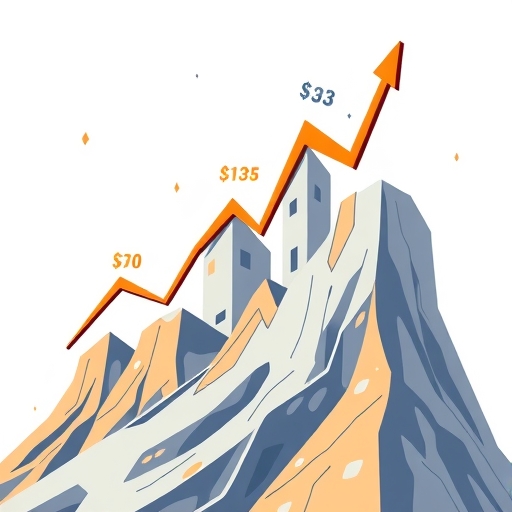Are You Ready to Invest in Tomorrow’s Leaders? A Guide to Top Growth ETFs for 2025
In the ever-evolving world of finance, the pursuit of long-term wealth often leads savvy investors toward opportunities that promise significant capital appreciation. This is where Growth Exchange-Traded Funds (ETFs) come into play. These powerful investment vehicles offer diversified exposure to companies expected to grow their earnings and revenue at an above-average rate, often found in cutting-edge sectors like technology, healthcare, and consumer discretionary. As we look ahead to 2025 and beyond, understanding the landscape of Growth ETFs is crucial for making informed decisions that align with your financial goals and the dynamic shifts in the global economy. In this article, we’ll explore what Growth ETFs are, highlight some of the most promising options, weigh their benefits and risks, and guide you through the process of selecting the right ones for your investment portfolio.

What Exactly Are Growth ETFs and Why Do They Matter?
Have you ever wondered how to invest in the next big thing without picking individual winners and losers? That’s where Growth ETFs shine. An Exchange-Traded Fund (ETF) is a type of investment fund that holds assets like stocks, commodities, or bonds and trades on stock exchanges just like regular stocks. A Growth ETF specifically focuses on companies that are expected to grow their sales and earnings at a faster pace than the broader market. These are often businesses that are reinvesting profits back into their operations for expansion, rather than paying out high dividends.
To further clarify, growth companies often exhibit certain characteristics that differentiate them from their value counterparts:
- Rapid revenue and earnings expansion, often reinvesting profits for future development.
- Focus on innovation, new technologies, or disruptive business models.
- Typically trade at higher valuation multiples due to high future earnings expectations.
Think of it this way: if you’re buying a piece of a growth company, you’re betting on its future potential. These companies typically operate in innovative fields, constantly developing new products or services. For example, many of the world’s leading technology firms, like Apple, Microsoft, and NVIDIA, are considered growth stocks because they consistently push boundaries and expand their market reach. By investing in a Growth ETF, you gain instant diversification across many such companies, which helps reduce the risk you’d face by putting all your eggs in one basket. This diversified exposure to innovation and future economic expansion is precisely why Growth ETFs are so appealing to investors seeking long-term capital appreciation.

Growth ETFs often track specific indices, like the Russell 1000 Growth Index or the Nasdaq-100, which are designed to capture the performance of growth-oriented companies. This passive management style often translates into lower operating costs, known as the expense ratio, compared to actively managed funds. A lower expense ratio means more of your money stays invested and compounds over time, directly boosting your long-term returns. While Growth ETFs can be more volatile than their “value” counterparts – which focus on undervalued, stable companies – they offer the potential for higher returns, especially during periods of strong economic growth and technological advancement.
Understanding the distinction between growth and value investing can help clarify the focus of Growth ETFs:
| Feature | Growth ETFs | Value ETFs |
|---|---|---|
| Investment Focus | Companies with high potential for future growth | Undervalued companies with stable earnings |
| Valuation | Higher price-to-earnings (P/E) ratios | Lower P/E ratios, often pay dividends |
| Sector Concentration | Often technology, healthcare, consumer discretionary | Often financials, industrials, utilities |
| Volatility | Generally higher volatility | Generally lower volatility |
Unlocking Potential: Top Growth ETFs for 2025 and Beyond
When considering Growth ETFs, we look for funds with solid track records, reasonable expense ratios, and strong underlying holdings that align with future market trends. Here, we present a selection of prominent Growth ETFs across different markets that warrant your attention for 2025 and the years to come.
U.S. Growth ETF Champions
- Vanguard Growth ETF (VUG): This ETF is a titan in the large-cap U.S. growth space, tracking the CRSP US Large Cap Growth Index. With an incredibly low expense ratio of just 0.04%, it offers broad diversification and includes top holdings like Apple, Microsoft, Amazon, NVIDIA, and Alphabet. It’s a fantastic choice for core growth exposure.
- Invesco QQQ Trust (QQQ): Famously tracking the Nasdaq-100 Index, QQQ is heavily concentrated in technology, communication services, and consumer discretionary sectors. Its expense ratio is 0.20%, and its top holdings mirror many of VUG’s, including Apple, Microsoft, Amazon, NVIDIA, and Meta Platforms. QQQ has an impressive track record, with an average annual return of 14.7% over the past decade.
- SPDR S&P 500 Growth ETF (SPYG): This ETF focuses on growth stocks within the S&P 500, selected based on factors like sales growth, earnings change, and price momentum. It boasts a low expense ratio of 0.04% and provides exposure to core growth leaders like Apple, Microsoft, and Amazon.
- iShares Russell 1000 Growth ETF (IWF): Covering large- and mid-cap U.S. growth companies, IWF tracks the Russell 1000 Growth Index. With an expense ratio of 0.19%, it offers deep liquidity and a diverse set of top holdings similar to VUG and QQQ.
- Schwab U.S. Large-Cap Growth ETF (SCHG): Another low-cost option (0.04% expense ratio), SCHG tracks the Dow Jones U.S. Large-Cap Growth Total Stock Market Index. It’s highly concentrated in information technology, offering robust exposure to this vital sector.
- ARK Innovation ETF (ARKK): For those seeking more aggressive, actively managed exposure to disruptive technologies like artificial intelligence, robotics, and genomics, ARKK is a notable choice. Its top holdings have historically included companies like Tesla, Roku, and CRISPR Therapeutics. However, its active management leads to a higher expense ratio (0.75%) and significantly higher volatility.
- T. Rowe Price Blue Chip Growth ETF (TCHP): This actively managed, nontransparent ETF focuses on strong, growing, and defensible businesses, often including many of the “Magnificent Seven” stocks. With an expense ratio of 0.55%, it targets high-quality large-cap growth.
Here is a quick overview of some top U.S. Growth ETFs mentioned, highlighting their key features:
| ETF Ticker | Expense Ratio | Primary Index/Focus | Key Holdings/Sectors |
|---|---|---|---|
| VUG | 0.04% | CRSP US Large Cap Growth | Large-cap U.S. growth, broad diversification |
| QQQ | 0.20% | Nasdaq-100 Index | Technology, communication services, consumer discretionary |
| SPYG | 0.04% | S&P 500 Growth Index | Growth stocks within S&P 500 |
Canadian Growth ETF Options
Canadian investors also have excellent opportunities to tap into domestic growth:
- iShares Canadian Growth Index ETF (XCG): This ETF provides exposure to Canadian large- and mid-cap growth companies, tracking an index of such firms. With a Management Expense Ratio (MER) of 0.55%, it’s tilted towards industrials and technology, with top holdings like Brookfield Corporation and Shopify.
- CI Morningstar Canada Momentum Index ETF (WXM): Utilizing a data-driven, multifactor approach, WXM identifies Canadian companies with strong fundamentals and positive price momentum. Its MER is 0.65%, and its sector allocations include financials, energy, and basic materials, offering a different flavor of growth.
International and Specialized Growth ETFs
- Vanguard International Dividend Appreciation ETF (VIGI): While having “Dividend Appreciation” in its name, VIGI focuses on gold-rated, large- and mid-cap foreign developed and emerging markets stocks that have consistently grown their dividends. This indicates high-quality, stable businesses with underlying growth, and it boasts a low expense ratio of 0.10%.
- Invesco S&P 500 GARP ETF (SPGP): This ETF takes a “Growth at a Reasonable Price” (GARP) approach, selecting stocks based on a combination of growth, quality, and value factors. With an expense ratio of 0.36%, it offers a diversified approach across sectors like healthcare, IT, and financials, aiming to capture growth without excessive valuation risk.
- Neuberger Berman Small-Mid Cap (NBSM): For investors interested in smaller companies with high growth potential, NBSM hunts for profitable, high-quality small-mid cap companies with modest valuations. It’s an actively managed fund with an expense ratio of 0.65%.
When selecting among these, remember that past performance does not guarantee future results. However, reviewing five- and ten-year track records can provide insight into how an ETF has performed across different market conditions.
Navigating the Landscape: Benefits and Risks of Growth Investing
Investing in Growth ETFs can be a thrilling journey, offering the potential for significant rewards, but it also comes with its own set of challenges. Understanding both sides of the coin is paramount for making informed decisions.
Potential Benefits of Growth ETFs
Why do so many investors gravitate towards growth?
- High Growth Potential: The primary appeal is the chance for substantial capital appreciation. Growth companies aim to expand rapidly, and successful ones can deliver impressive returns that outpace the broader market. The Morningstar US Large Growth Index, for example, significantly outperformed the Morningstar US Large Value Index by 23 percentage points from early 2023 through January 2025.

- Diversification: Unlike buying a single growth stock, an ETF spreads your investment across dozens or even hundreds of companies. This reduces the impact if one particular company underperforms.
- Exposure to Innovation: Growth ETFs often concentrate on sectors at the forefront of technological advancement and economic change, such as artificial intelligence (AI), clean energy, and healthcare breakthroughs. This allows you to participate in the future’s most dynamic trends.
- Simplicity and Accessibility: Buying an ETF is as easy as buying a stock, offering liquidity and ease of trading. It’s a straightforward way for individual investors to access a professionally managed, diversified portfolio of growth stocks.
- Compounding Long-Term Growth: Reinvesting the gains from these fast-growing companies allows your money to compound over time, potentially leading to significant wealth accumulation over a long investment horizon.
- Lower Costs: Many passively managed Growth ETFs boast very low expense ratios, meaning more of your investment goes to work for you rather than being eaten up by fees.
Potential Risks of Growth ETFs
However, no investment is without its downsides. What should you watch out for?
- Higher Volatility: Growth stocks are often seen as riskier because their valuations are based heavily on future earnings expectations. If these expectations aren’t met, or during market downturns, their prices can fall more sharply than those of more established, value-oriented companies.
- Valuation Risk: Growth stocks typically trade at higher price-to-earnings (P/E) ratios. This means investors are paying more for each dollar of current earnings, betting on future growth. If that growth doesn’t materialize, or if interest rates rise and discount future earnings more heavily, these valuations can become unsustainable, leading to significant price corrections.
- Interest Rate Sensitivity: Growth companies often rely on borrowing to fund their expansion. When interest rates rise, their borrowing costs increase, and the present value of their future earnings (which are a big part of their appeal) decreases. This can put downward pressure on their stock prices.
- Concentration Risk: While diversified within growth, many Growth ETFs can be heavily concentrated in a few sectors (e.g., technology) or even a handful of very large companies (like the “Magnificent Seven” – Apple, Microsoft, Amazon, NVIDIA, Alphabet, Meta Platforms, Tesla). This means their performance can be heavily tied to the fortunes of those specific areas or companies.
- No Guarantees: The future is unpredictable. Even the most promising growth companies can face unforeseen challenges, new competition, or shifts in consumer demand, impacting their ability to deliver on growth expectations.
Investors should also be aware of common factors that can amplify the risks associated with growth investing:
- Economic downturns often impact growth companies more severely due to their reliance on future earnings.
- Regulatory changes or increased competition can quickly dampen growth prospects.
- Over-reliance on a few key products or services makes them vulnerable to market shifts.
Understanding these benefits and risks helps you approach Growth ETF investing with a balanced perspective, allowing you to weigh the potential rewards against your personal risk tolerance and financial objectives.
Your Blueprint for Success: Key Factors in Choosing a Growth ETF
With so many Growth ETFs available, how do you sift through the options to find the best fit for your portfolio? It comes down to a few critical factors that help you evaluate each fund’s potential and suitability.
When we approach selecting a Growth ETF, we focus on these essential criteria:
- Expense Ratio: This is arguably one of the most important factors for long-term investing. The expense ratio is the annual fee you pay as a percentage of your investment. Even a difference of a few basis points (hundredths of a percent) can significantly impact your returns over decades. Look for ETFs with low expense ratios, ideally below 0.20% for passively managed funds. For example, VUG and SPYG both have a stellar 0.04% expense ratio.
- Top Holdings and Sector Concentration: What companies does the ETF actually own? Examine its top holdings to understand the underlying businesses you’re investing in. Are they the innovative leaders you expect? Also, assess the sector allocation. While growth often means a tilt towards technology, are you comfortable with that level of concentration, or do you prefer a more diversified sector mix (like with SPGP’s GARP strategy)?
- Diversification within the Fund: Beyond sector concentration, how diversified is the fund across different company sizes (large-cap, mid-cap, small-cap) and individual stocks? A well-diversified ETF will spread risk more effectively.
- Performance and Liquidity: Review the ETF’s historical performance over various timeframes (e.g., 1-year, 5-year, 10-year). While past performance is not indicative of future results, it can show how the fund has navigated different market cycles. Also, check its liquidity, which refers to how easily you can buy and sell shares without significantly affecting the price. High daily trading volume is a good sign of liquidity.
- Investment Theme and Strategy: Does the ETF’s specific investment theme align with your goals? Are you looking for broad U.S. large-cap growth (like VUG), a tech-heavy focus (like QQQ), or a more specialized approach like disruptive innovation (ARKK) or Canadian momentum (WXM)? Understand the index it tracks or the active management strategy it employs.
- Track Record and Fund Issuer: Consider the history of the fund and the reputation of the company that issues it (e.g., Vanguard, iShares/BlackRock, Invesco). Established issuers often have robust research teams and a long history of managing funds.
To simplify the selection process, consider these core factors when evaluating Growth ETFs:
| Factor | Importance | Consideration |
|---|---|---|
| Expense Ratio | High | Lower fees mean more returns over time. |
| Top Holdings | High | Understand the underlying companies and sectors. |
| Diversification | Medium | Spread across companies, sectors, and market caps. |
| Performance | Medium | Review historical performance across various market cycles. |
To assist in your analysis, powerful tools like InvestingPro can provide in-depth analysis, comparison tools for expense ratios, performance, holdings, sector breakdowns, and risk metrics. Platforms like Stash also curate top-performing options, offer affordable investing, and provide real-time insights, helping you make informed decisions.
Remember, your personal risk tolerance and investment horizon are crucial. If you’re a long-term investor (5+ years) with a higher tolerance for market fluctuations, Growth ETFs can be a suitable component of your portfolio. For beginners, broadly diversified, low-cost options like VUG or SPYG might be a more manageable starting point.
Looking Ahead: Future Trends and Long-Term Outlook for Growth
The investment landscape is constantly changing, and several powerful trends are expected to drive growth in 2025 and beyond. Understanding these macro factors can help reinforce the long-term potential of growth-oriented investments and how they fit into your overall portfolio strategy.
We are witnessing a profound digital transformation that continues to accelerate. Key technological advancements are at the forefront of this shift:
- Artificial Intelligence (AI): From enhancing business efficiency to revolutionizing healthcare and everyday life, AI is poised to be a massive growth driver across countless sectors. Companies developing AI infrastructure, software, and applications are prime candidates for growth.
- Clean Energy and Sustainability: The global push towards decarbonization and sustainable practices is creating enormous opportunities in renewable energy, electric vehicles, battery technology, and green infrastructure. This sector is not just about environmental impact; it’s about significant economic expansion.
- 5G Connectivity and the Internet of Things (IoT): The rollout of 5G networks is enabling faster, more reliable connectivity, which in turn fuels the growth of the Internet of Things – a vast network of connected devices. This trend creates new markets and enhances existing ones, from smart cities to advanced manufacturing.
- Healthcare Advancements: Innovations in biotechnology, genomics, personalized medicine, and digital health solutions continue to drive growth in the healthcare sector, addressing global health challenges and improving quality of life.
These trends suggest that companies positioned in these areas are likely to exhibit above-average earnings and revenue growth for the foreseeable future, making Growth ETFs that capture these themes particularly relevant.

When building a growth-focused portfolio, it’s wise to diversify not just across different Growth ETFs, but also by balancing them with other asset classes or investment styles if appropriate for your goals. For instance, combining growth with a small allocation to value or income-producing assets can help manage overall portfolio volatility. It’s also important to consider the tax implications. Growth ETFs, especially those with lower dividend yields, are often suitable for tax-advantaged accounts like Registered Retirement Savings Plans (RRSPs) and Tax-Free Savings Accounts (TFSAs) in Canada, or Roth IRAs and 401(k)s in the U.S., allowing your capital to grow without immediate taxation on gains or dividends.
Ultimately, a long-term investment horizon is key for Growth ETFs. While they can experience short-term fluctuations, their potential for compounding returns over many years is their most compelling feature. By staying informed about market trends, continuously monitoring your chosen ETFs, and maintaining a disciplined approach, you can strategically position your portfolio to benefit from the innovation and economic expansion that growth companies are driving.
Conclusion
Growth ETFs offer a compelling avenue for investors aiming to capitalize on innovation and achieve long-term capital appreciation. By providing diversified exposure to dynamic companies and sectors, these funds simplify the investment process while potentially delivering strong returns. We’ve seen how options like Vanguard Growth ETF (VUG) and Invesco QQQ Trust (QQQ) lead the U.S. market, while iShares Canadian Growth Index ETF (XCG) offers domestic opportunities.
While it’s essential to understand the associated risks, such as higher volatility and valuation concerns, a careful analysis of factors like expense ratios, underlying holdings, and investment themes can help you make informed decisions. By leveraging analytical tools and maintaining a long-term perspective, you can strategically integrate Growth ETFs into your portfolio for 2025 and the years to come, aligning your investments with the future leaders of the global economy.
Frequently Asked Questions (FAQ)
Q: What is a Growth ETF?
A: A Growth Exchange-Traded Fund (ETF) is an investment fund that focuses on companies expected to grow their earnings and revenue at an above-average rate, often found in innovative sectors like technology and healthcare. It provides diversified exposure to these companies, trading like a stock on exchanges.
Q: What are the main benefits of investing in Growth ETFs?
A: Key benefits include high potential for capital appreciation, diversification across many growth companies, exposure to cutting-edge innovation, and often lower costs compared to actively managed funds. They allow investors to participate in future economic expansion.
Q: What are the primary risks associated with Growth ETFs?
A: The main risks involve higher volatility compared to value investments, valuation risk due to higher price-to-earnings ratios, sensitivity to interest rate changes, and potential concentration risk if the ETF is heavily weighted in a few sectors or companies.
Disclaimer: This article is intended for informational and educational purposes only and does not constitute financial advice. Investing involves risks, including the potential loss of principal. Always consult with a qualified financial professional before making any investment decisions.



No responses yet